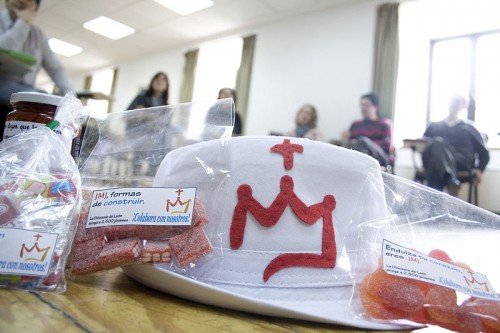Rounding up Madrid's 'Popestock'
 I'm often amazed by anything that can get a million or so young people to do anything or gather anywhere in one location. The Roman Catholic Church managed to do that at World Youth Day (or, what Rocco Palmo calls "Popestock"), which concluded in Madrid yesterday.
I'm often amazed by anything that can get a million or so young people to do anything or gather anywhere in one location. The Roman Catholic Church managed to do that at World Youth Day (or, what Rocco Palmo calls "Popestock"), which concluded in Madrid yesterday.
"The pope draws 1.5 million young people to Madrid – but that's not news?" Andrew Brown writes for The Guardian. He notes how German broadcaster Deutsche Welle ran with this angle:
Pope Benedict XVI urged Spain to preserve its Christian heritage during a visit to the Spanish capital Thursday as part of the World Youth Day celebrations. Spain's Christian identity was a "great treasure" which should be "cared for constructively," the pontiff said.But the pope's taxpayer-funded trip to Madrid has stirred much anger in a country where the economy is floundering and 40 percent of youth have no jobs.
Around 5,000 people turned out on Madrid's streets late Wednesday to protest the pope's arrival for the six-day youth festival. The demonstrators included members of secularist, feminist, gay and lesbian, alternative Christian and leftist groups.
Brown argues the following over at The Guardian.
Of course this demonstration is news. But the ability of mainstream Christianity to attract a crowd of 1.5 million young people seems to me a damn sight more newsworthy, since we expect people to protest against the pope, and we do not expect them to turn out in large numbers to support or see him.
Numbers don't prove truth, of course. But they are measures of commitment, and of political importance. Three hundred times as many people have travelled to Madrid to see the pope as have travelled to protests against him. Which group is more important to know about?
As Laura commented in Mollie's earlier post, the New York Times noted at the end of their story that the event might offer a financial advantage to Spain's struggling economy.
The organizers of the pope’s visit, however, have strongly defended its cost, 50 million euros, or about $71 million, insisting that it has been covered by pilgrims’ registration fees and corporate sponsorship. On Wednesday, José Blanco, spokesman for the government and one of Mr. Zapatero’s most senior ministers, added his support, saying that the government’s calculations showed that the event would yield a financial benefit for the Spanish economy.
This paragraph, however, ends an article that mostly focuses on the protests. Commenter Passing By noted that many outlets focused on the economic side of the event. Christopher Stefanick thinks that the concept of mainstream media is changing anyway. How many Catholic youth are looking for CNN or New York Times articles about the event, compared to those reading their Facebook feeds?
Along those lines, it could well be that this article is your first wind of any bad press at all about World Youth Day. That’s understandable. If you Google “World Youth Day,” there’s so much Catholic news, positive press, and so many youth group websites that it takes several pages to find a negative story from mainstream media.
Maybe what constitutes “mainstream” is changing. A million youth that just got home from Spain probably think so.
This tends to be the argument people use when they don't like media coverage, but it's difficult to ignore the mainstream media's influence on how others perceive World Youth Day. The pope announced at the end of Mass on Sunday that the next international event would be in Rio de Janeiro in 2013. Let us know if you found particularly good or bad angles from this year's event.